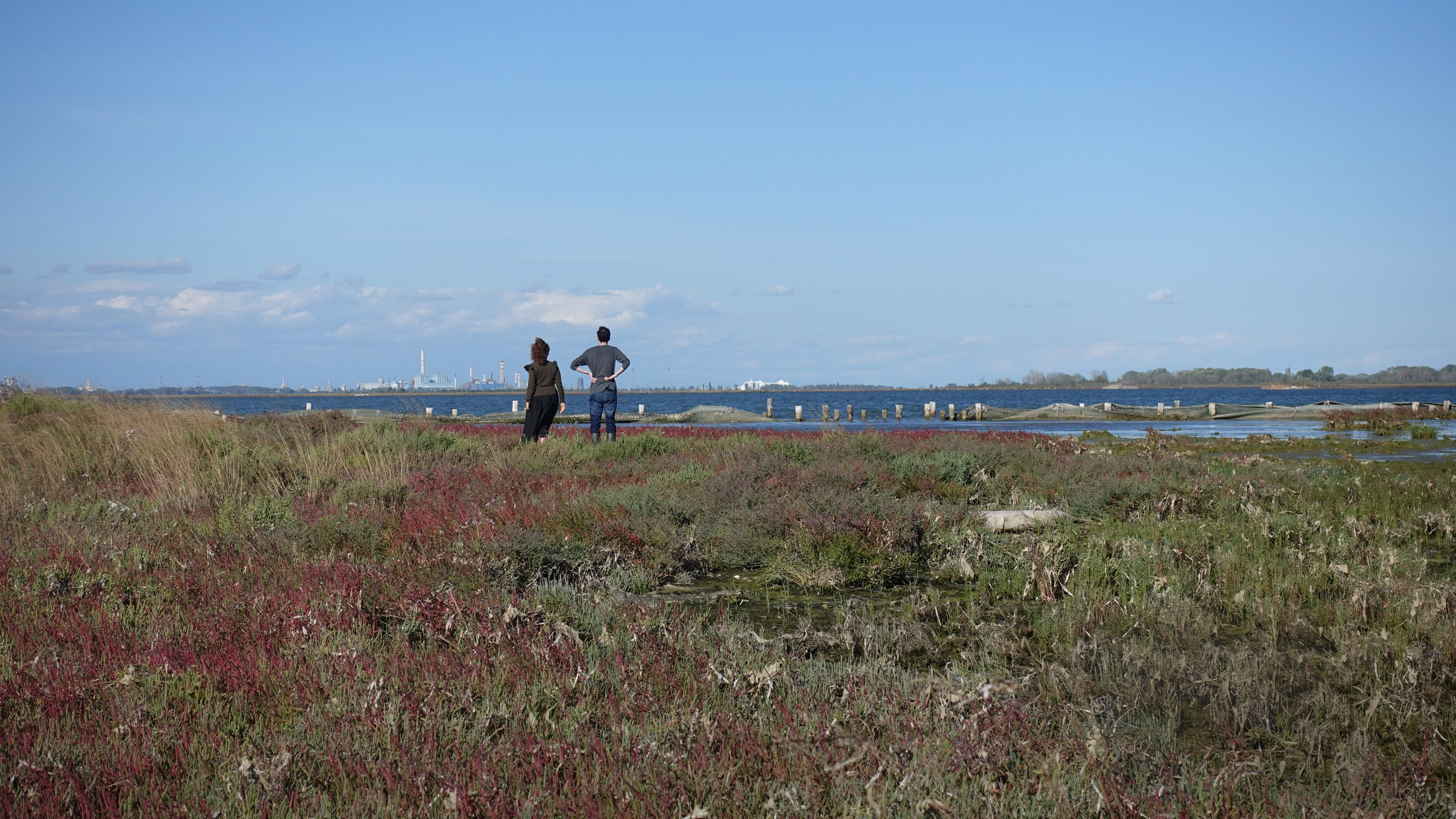Scientists see the sinking city as a laboratory for environmental solutions.
Venice, Italy, is suffering from a combination of subsidence—the city’s foundations slowly sinking into the mud on which they are built—and rising sea levels. In the worst-case scenario, it could disappear underwater by the year 2100.
Alessandro Gasparotto, an environmental engineer, is one of the many people trying to keep that from happening. Standing on a large mudflat in the center of the Venetian lagoon, he pushes a hollow three-foot-high metal cylinder called a piezometer into the thick black mud. This instrument will measure how groundwater moves through the sediment as the lagoon’s tides rise and fall. Knowing what’s happening under the mud is crucial for understanding whether, and how, vegetation can grow and eventually transform this barren landscape of mud into a salt marsh.
Gasparotto’s work with salt marshes is part of a project steered by the NGO We Are Here Venice (WAHV) and funded by the EU through the WaterLANDS research program, which is restoring wetlands across Europe. The Venice chapter has been granted €2 million over five years to investigate whether artificial mudflats—the deposits that result when the lagoon is dredged to create shipping channels—can be turned back into the marshes that once thrived in this area and become a functioning part of the lagoon ecosystem again.
“The history of the city of Venice has always been intertwined with the history of the lagoon,” explains Andrea D’Alpaos, a geoscientist at the University of Padova. The health of Venice depends on the health of the lagoon system, and vice versa.
This relationship is not only economic—protecting the lagoon ecosystem bolsters fishing yields, for example—but also infrastructural. Salt marshes have a buffering effect on tidal currents, attenuating the force of waves and reducing the water’s erosive effect on Venice’s buildings.
But the marshes have been declining for centuries. This is due in part to waterway mismanagement going as far back as the 1500s, when Venetians diverted rivers out of the lagoon, starving it of sediment that would naturally be borne in on their currents. The building of breakwaters at three inlets on the Adriatic Sea and the excavation of an enormous shipping canal in the late 1900s further eroded the marshland.
And while the city has been the beneficiary of thousands of euros in restoration and prevention work—most notably the €6.2 billion MOSE (the Italian acronym for “Experimental Electromechanical Module”), a colossal (and extremely effective) system of mobile sea barriers designed to keep the Adriatic’s floodwaters from the city—the marshes have been overlooked.
Construction of MOSE began in 2003, but delays, cost overruns and a corruption scandal stalled its completion. It was activated for the first time, successfully preventing a flood, in 2020. Paradoxically, it is the MOSE technology, which protects the city, that is damaging the lagoon ecosystem.
“When the MOSE system is raised, it stops storm surges and prevents Venice flooding,” D’Alpaos says. “Storm surges are bad for Venice, but they are good for marshes; 70% of sediment that reaches the marsh is delivered during storm surges.”
These excessively high tides, D’Alpaos continues, are happening more often. The problem, he says, is that “if you close the lagoon too often or for too long, you prevent sediment reaching marshes.” In the more than 20 years that he has been studying the lagoon, he says, he’s seen marshes disappearing at an alarming rate: “The marshes are drowning. Two centuries ago, the Venice lagoon had 180 square kilometers [69 square miles] of marshes. Now we only have 43 square kilometers.”
One of the sites the We Are Here Venice team is working is on a natural salt marsh, hugged on one side by a kidney-shaped platform of infill dredged from the lagoon. In places where the mud is dry, the ground has separated into patches that conjure small tectonic plates, littered with bone-white crab claws picked clean and dropped by gulls flying overhead. Three orange sticks mark the spot where a fence between the salt marsh and the infill will be removed to allow water exchange and the movement of sediment, making the two ecosystems “speak to one another,” as Jane da Mosto, the executive director and cofounder of WAHV, describes it.
Tramping over the island in rubber boots, releasing gobbets of black mud at every step, da Mosto explains that “all of this represents a kind of natural capital.” Not only do the marshes store carbon, but “these environments also support fish habitats and a huge bird population,” she adds. Even the samphire, an edible marshland plant, “could be cultivated like a crop.” Marshes are also more efficient carbon sinks than forests, because marshland plants that store carbon are gradually buried under sediment as the tide washes over them, trapping the carbon for as long as centuries.
Da Mosto sees the city as something of a laboratory for environmental solutions with wider applications. “Venice is a mirror on the world,” she says. “If the city remains an example of all the world’s problems, as it is now, then there’s no point trying to keep it alive. But we should be able to show how to turn infills into ecologically productive salt marshes and how to transform an economy based on mass tourism into an economy based on its natural capital.”
Catherine Bennett is a freelance journalist based in Paris.








